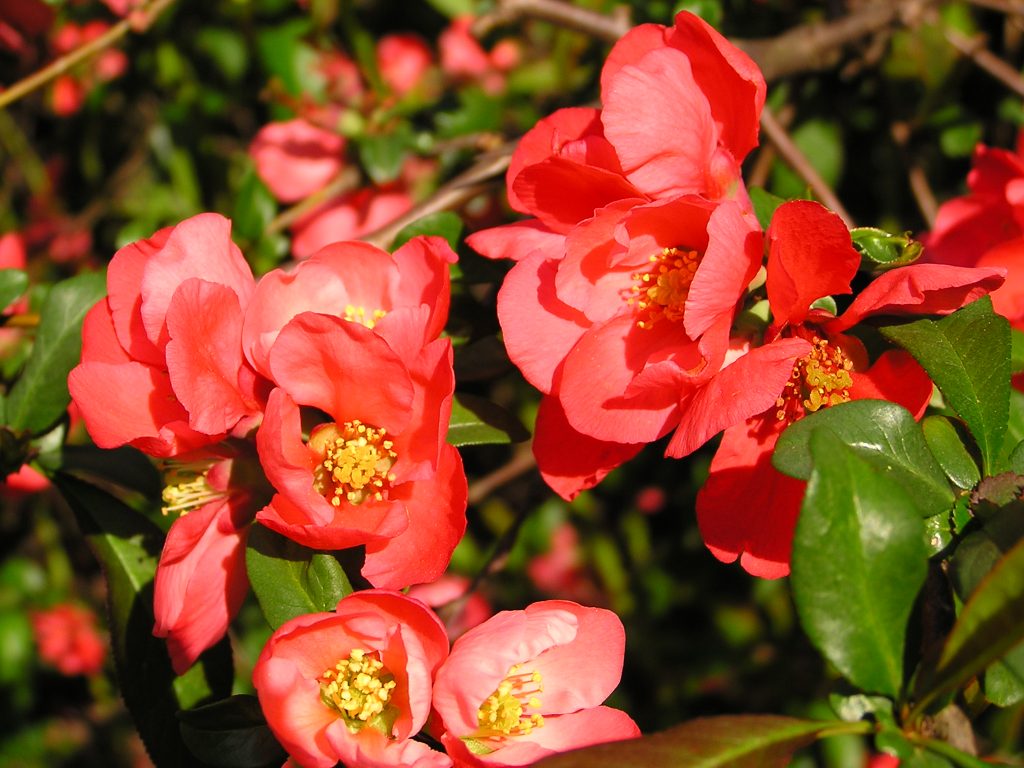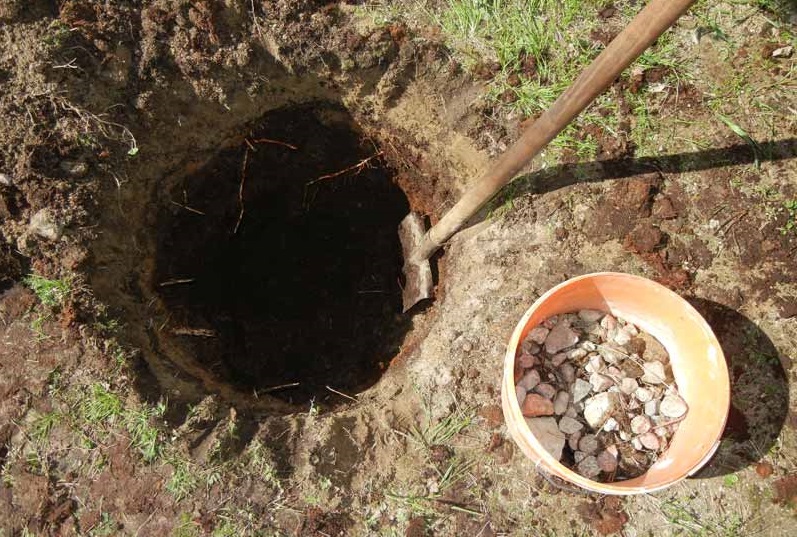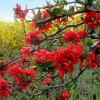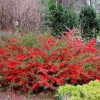Secrets of growing Japanese quince
Content
Description
Japanese quince is a sprawling shrub up to 1 - 2 m tall with thorny, beautiful arc bending shoots and small shiny leaves. It blooms in May for 3 - 4 weeks, luxuriantly covering the shoots, bright scarlet flowers almost hide the leaves just beginning to open. Breeders have bred varieties with double and semi-double pink and white flowers. This thermophilic plant loves sunlight, but tolerates partial shade well, winter frosts down to -30 degrees can damage young annual shoots, and an adult bush winters well under the snow. It is better to cover young bushes with lutrasil for the winter, while adult bushes are sprinkled with leaves and covered with snow.
Fruiting begins in the third - fourth year of the shrub's life; Japanese quince is famous for its fragrant and very healthy fruits, which ripen in September - October. Fruits are small, tough and sour, half of the fruit is occupied by seed boxes, but they contain so many nutrients that they can heal the body. Traditional medicine recommends using them for various diseases. They contain much more ascorbic acid than lemons. Carotene, pectin, vitamins, iron, manganese, calcium, potassium - all this is preserved even after heat treatment, so delicious desserts (jams, jellies, marmalades, confitures, compotes) made from fruits are very useful. Japanese quince is low, more precisely, its yellow pear-like or rounded fruits, helps with hypertension, sclerosis, diseases of the stomach and gall bladder.
The fruits must be harvested before frost, even if they are not ripe, because under the influence of frost they lose their taste and benefits, they become unsuitable for processing.
Video "Description"
From the video you will learn what this shrub looks like.
Landing
Japanese quince is planted in the spring before the start of sap flow or in the fall three to four weeks before the onset of frost. It is necessary to plant a shrub immediately in a permanent place, its root grows long, it is injured when digging up, it is undesirable to transplant the plant, it may not take root in another place. Usually, annual seedlings are sold with an open root system, and two-year-olds are sold in a container, they are planted with their own earthen clod, which helps young plants to endure stress.
Japanese quince, planting and caring for which does not require too much effort and time, loves warmth and sun, which means that you need to choose an open place for it, on the south or southwest side of the buildings. It can grow in light partial shade, but the larger the shade, the smaller the fruits will be, the slower the shoots will develop. It is advisable to prepare the soil in advance, the preferences of Japanese quince are in the rejection of heavy, too wet, alkaline, too acidic, peaty soils. She likes loose, breathable neutral soils, rich in humus, without stagnant water. If the soil at the selected location does not meet the requirements, it must be prepared.
For spring planting, in the fall, they clear a place, select all the roots of perennial grasses, dig up, add sand and leafy soil if necessary, add humus or compost, superphosphate and potassium salt. At a depth of 15 cm, loose fertile soil should form, which is watered and left until spring.
In the spring, a pit with a diameter of 40 cm and a depth of up to 80 cm is prepared in a prepared place. The earth from the pit is mixed with humus, ammonium nitrate, superphosphate, and wood ash. Part of it is poured into a pit, a seedling is placed and covered so that the root collar is at ground level. It is not necessary to leave it on top so that it does not freeze, but it is not worth deeply deepening - not to provoke the growth of wild growth, it is best to focus on the level that was in the nursery.
If the quince (chaenomeles) does not grow singly, but in a group, then you do not need to plant the shrubs closer to each other than after 50 cm, they are planted a little closer only for a hedge so that the plants close together.
Care
Japanese quince, of course, appreciates care, but it will grow even if it is forgotten. But then it may turn out that the shrub has grown terribly, occupies an ever larger area, does not bear fruit, and forms fewer flowers or freezes in winter. To prevent this from happening, you need to look after the plant - water, cut, feed, cover for the winter. Quince requires cross-pollination for the formation of fruits, therefore, at least one more plant of a different variety must grow on the site (possibly a neighbor).
Winter care
Even varieties that are declared frost-resistant must be protected from winter frosts and blizzards. The shoots of the first year, not covered with snow, usually freeze out at temperatures below -20 degrees, there are no fruits on the branches affected by frost. But the deep bedding of the roots, more precisely, the long powerful root of an adult plant will save it from complete freezing, but with young bushes you need to be decisive and cover them completely.
The land around the shoots is mulched in the fall with compost, earth with sand, sawdust, crushed bark, pine nut skins to a height of 10-15 cm, capturing an area equal to the projection of the crown. Young, not very overgrown bushes are wrapped in lutrasil or similar material, in winter they are covered with snow. Adult bushes are covered with dry leaves of fruit trees, and covered with spruce branches on top. It is necessary to deliberately hold back the snow, throw it on the bushes. Under a snowdrift, if the snow lasts until the end of winter, the Japanese quince will winter well, no matter how cold it comes.
Watering
Growing and caring for quince requires proper watering. This plant tolerates a lack of moisture more easily than an excess of it. It is enough to water adult bushes once a month, but abundantly so that the water gets to a depth of more than a meter; in the complete absence of rain, they are watered more often - after 2 - 3 weeks.
And young seedlings are well watered after planting, then they moisten the ground every decade (if there is no rain), gradually increasing the interval between waterings. In the summer, when the ground warms up enough, the area under the bush is loosened to a depth of 10 cm, and mulched after watering. The cleanliness of the land must be monitored all the time, weeds must be removed, but it is enough to loosen deeply twice a season - at the beginning of summer and in autumn.
Top dressing
If, during planting, the site was well prepared and the hole was filled with fertilizers, then liquid fertilizing begins to be applied in the second, or even in the third year of life. In early spring and with the beginning of flowering, the plant needs nitrogen fertilizers, and in the fall potash-phosphorus fertilizers are applied, which will help to gain strength for wintering.
Quince takes humus well, which is laid out in early spring under a bush, liquid top dressing with a solution of bird droppings, wood ash, superphosphate, potassium salts, ammonium nitrate.
Liquid dressings are applied after watering so that their consumption is slow and gradual. The first year the plants are not fertilized after planting.
Pruning
In the spring, sanitary pruning is carried out annually - they remove frozen or injured shoots, remove excess root layers, which grow in large quantities every year. If they are not removed, then the bush grows at an incredible speed - a twenty-year-old plant can occupy an area of 2 square meters. Cut shoots growing parallel to the ground or inside the bush, forming its crown. Before cutting the chaenomeles, you need to disinfect sharp tools (saw, pruning shears) and protect your hands from thorns with thick gloves.
When the bush reaches the age of 8 - 10 years, they begin to carry out anti-aging pruning, remove shoots older than five years, keeping about 15 shoots. Quince tolerates pruning well, hedges are sheared annually, giving it the desired shape, shortening all the shoots, and not just removing the excess ones.
Diseases
Chaenomeles gets sick very rarely, but if a cold, wet summer happens, fungal diseases may threaten, and then the bushes are treated with an ash solution, or special fungicides are used.
Usually, pests do not bother the bushes, but if aphids or caterpillars appear, the plant is treated with a copper-soap solution or infusion of onion peels.
The damaged parts of the plant are cut off and destroyed, and when processing the bush, they cultivate the land under it and next to it.
Reproduction
If Japanese quince is already growing on the site, reproduction is easy - this can be done with seeds, cuttings, root suckers or grafts. Seeds are taken from ripe fruits in autumn, and then sown before winter. They will grow beautifully in the spring and grow in the open field to the state of adult seedlings, which are already transferred to a permanent place, you only need to thin them out. If in the fall it was not possible to sow them until frost, then the seeds can be left until spring, but then they are placed in wet sand, wrapped in a plastic bag (you just need to make holes for air), keep for 2 - 3 months on the bottom shelf of the refrigerator at temperatures from +3 up to +5 degrees. Thus, the seeds will undergo stratification at home, then they are transferred to warmer conditions, and after they hatch, they are planted in peat cups or other seedling dishes. They are allowed to grow up at home, so that they can then be transplanted to a permanent place of growth.
The seeds almost always have one hundred percent germination, they grow healthy, strong plants, which are then used as a stock, since they do not retain the characteristics of the mother plant. But the root suckers and layering perfectly retain all the characteristics of the variety, but they are not so strong, their roots are located for a long time at the very surface of the earth, they are not taken as often as we would like. The offspring are simply separated from the bush along with the root, transplanted. And the layers are rooted by digging in the lower shoot in the spring. By autumn, it can already be cut into several parts with separate roots and planted, or you can do it next spring so that young plants do not freeze in winter.
A cut of varietal quince is grafted to the seedlings using methods of splitting, budding or copulation. Several cuttings can be grafted onto a strong stock in early spring, but budding is carried out in the second half of summer.
Breeding with cuttings gives good results, but not all of them take root, the best result is 50%.
Varieties of varieties
The genomeles genus consists of only three natural species and a number of interspecific hybrids, hundreds of varieties have been bred on their basis today, but our weather and climatic conditions do not allow us to grow so many.
Japanese quince "Golden Apple" with large red flowers grows up to 2 m. It is considered frost-resistant, tolerates partial shade and drought well.
Low Japanese quince is a species that grows in our middle lane, its growth does not exceed 1 m.Common varieties are: "Pomegranate Bracelet" with bright red flowers, "Rising Sun" with soft cream, "Sargent", "Red Joy" with red flowers.
Still grown tall up to 1.5 m "Hollandia" with a rounded crown and pink flowers, "PinkLady" with pink flowers of varying intensity.
Fruits with a red blush are given by "Crimsonand Gold", with a spreading crown and dark red petals and yellow stamens.
Cultivation and Care Video
From the video you will learn how to grow and care for this decorative tree.



